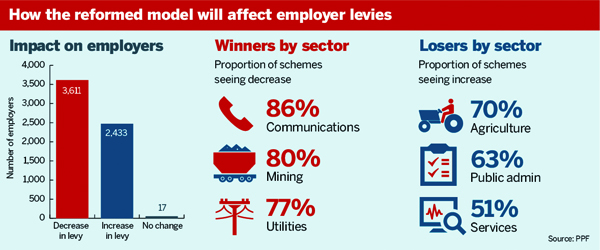Schemes will be able to more precisely focus their efforts to reduce their Pension Protection Fund levy, following the lifeboat’s proposals to make its insolvency risk system more transparent.
Funding experts predicted schemes will be able to focus more precisely their efforts to reduce their Pension Protection Fund levy, following the lifeboat’s proposals to make its insolvency risk system more intelligible.
Trustees will now be able to check data used by the PPF to calculate its pension protection score, the previous monthly scores and whether the appropriate scorecard is being used, after the PPF’s switch to the Experian risk solvency system.
Under the new scoring system up to 1,500 employers will see an average 150 per cent increase in their levy, while 2,100 schemes will see a decrease of an average of 40 per cent, according to PPF figures.

The changes were outlined ina consultation issued by the fund as part of a switch from a model provided by Dun & Bradstreet.
Schemes will also be sent an email when this score changes.
“The most important thing once the numbers come out and you get access to your portal [is] to build up an understanding of how the PPF views you risk-wise and how you can change that,” said Calum Cooper, head of trustee consulting at Hymans Robertson.
The levy will use scores from October 31 this year in calculations for 2015-16. The PPF is also considering allowing access to the portal via the Pensions Regulator’s Exchange database.
The model proposed will focus more on financial data, accessed via public sources such as Companies House and provided by the scheme, rather than non-financial data such as a sponsor’s board composition.
Non-financial data is “based on a very generic, overall review of all UK businesses,” said Martin Clarke, the fund’s executive director of financial risk.
The model is designed to place greater emphasis on the specific risks of companies with defined benefit schemes, he added.
“So what we have been able to do is look at our experience over the last eight to nine years, at specifically the proportion that we have covered and the PPF protection,” said Clarke.
Under the new scoring system up to 1,500 employers will see an average 150 per cent increase in their levy, while 2,100 schemes will see a decrease of an average of 40 per cent.
The emphasis on non-financial data meant a “very strong company may have suffered because of that,” Clarke said.
“What we’ve found with the implementation of the current system is that it was that particular component that made levy scores particularly volatile,” said Clarke.
The PPF will also take into account a scheme’s investment strategy and for the first time will take into account a parent company’s financial strength without a guarantee in place.
It is therefore important trustees make them aware of strategies such as liability-driven investment, which are designed to mitigate risk, Cooper said.
A focus on financial data will mean there is less scope for making changes, such as altering the composition of the board to reduce its levy, said Francois Barker, head of pensions at Eversheds.
“I think it’s going to come down to getting parents into a stronger position,” said Barker. “The core financial parts will have more of an impact on your levy now than they did before.”
However the PPF plans to take a more rigorous view in incorporating asset-backed contributions into its levy calculations.
“Most of these do rely on the condition of the business,” said Clarke.
This means they will “probably have less value in terms of reducing liabilities for levy purposes,” Clarke said.














